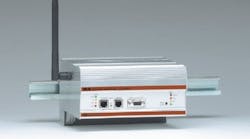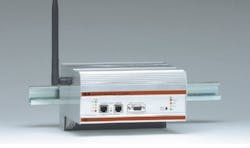The worldwide market for wireless technology will grow 26% annually over the next few years, forecasts the ARC Advisory Group, Dedham, Mass., in its “Wireless Technology in Process Manufacturing” report issued in August 2006.
According to ARC senior analyst Harry Forbes, that market was worth $325.7 million in 2005 and should rise to more than $1 billion by 2010. Driving that demand is a spreading realization among potential end users not only of the cost savings that accrue from doing away with wires but also, in Forbes’ view, of the “ability of wireless applications to enable new and better ways of operating manufacturing plants” — ways that will benefit chemical makers more than most, he says. So, wireless is coming, but in what ways, to what parts of the plant, and when?
The emphasis here, of course, is on the plant. Wireless communications have served for many years for remote monitoring in industries like oil and gas production and in water and power utilities. However, the potential for wireless technologies to link field devices and control systems in the plant is creating a groundswell of interest in the chemical industry.
Intense interest
“Almost every customer specification that comes in, from a systems level perspective, is talking about wireless at the moment,” says Hesh Kagan, director of technology for services, applications, and solutions marketing at Invensys Process Systems (IPS), Foxboro, Mass., and president of the Wireless Industrial Networking Alliance (WINA), San Ramon, Calif. “They may not be demanding wireless technology but they are asking for an upfront explanation of how we would approach the project from a wireless perspective.”
“From the level of interest we’re getting from our customers, we have a huge potential for wireless to be rapidly accepted and deployed in the market,” agrees Bob Karschnia, vice president of technology at Emerson Process Management, Austin, Texas. “Customers are fueling the industrial wireless revolution … it’s clear that we are at the tipping point for wireless to have a real impact in the plant,” notes Jack Bolick, president of Honeywell Process Solutions, Phoenix, Ariz.
So far, however, the actual impact of wireless has been limited, at least from a purely process point of view. Honeywell says it has installed its established XYR 5000 wireless transmitters at more than 200 sites around the world, along with mobile handheld devices such as the IntelaTrac PKS and the mobile Experion Station, but its process push will tie into the work of standards-making organizations such as the SP100 Committee of ISA, Research Triangle Park, N.C., the HART Communications Foundation (HCF), Austin, Texas, with Wireless HART, and through WINA. Honeywell, like most major control companies, is involved with all three groups.
An educational job still needs to be done, notes Ron Helson, HCF executive director, and not just for wireless. “Of the more than 20 million smart devices installed around the world, probably only 10% of them are actually connected to systems where users can take advantage of their intelligent capabilities,” he laments. “We see wireless helping to address that problem and enabling industry to get connected to those smart instruments. The biggest use for wireless is to allow users to access more easily information about their plant assets,” he says, echoing a comment credited to Honeywell’s Bolick that one of the main applications of wireless is to connect many more sensors than was previously cost effective directly to the process historian, rather than via the control loop.
Wireless also “opens up many more opportunities for incremental process measurements, says Kagan. What we hear from our customers is that, as a rule of thumb, if budgets were unconstrained, they would go out and instrument another 15% to 20% of the points they have. Wireless allows those budget dollars to go a lot further.”
Vendors respond
With beta testing of products expected early this year, Honeywell’s new wireless systems will use high-speed frequency-hopping spread-spectrum (FHSS) networks and “go anywhere” sensors with self-contained power sources and battery life of up to 10 years. The systems will feature integrated IEEE 802.11 networks (similar to WiFi) for sensors and handhelds and will operate on the globally available 2.4-GHz band. “This is our next generation system,” says Dave Kaufman, business development director for wireless, “and existing Honeywell wireless devices can connect to this system as a sub-network through a gateway.” Bolick describes the result as akin to a “wireless cloud,” a single multifunctional network supporting everything from security sensors to building management, asset management to process sensors.
IPS’s wireless strategy, announced at the 2005 ISA Expo in Chicago, relies on shared-access-point technology and common data and security models for all wireless devices, regardless of vendor or application. In effect, IPS takes on the management of all wireless services across the plant — an approach that has been successfully implemented at PPG Industries’ chlor-alkali complex at Lake Charles, La. (see Wireless wins wider role).
Completed in June 2006 by IPS and its strategic partner Apprion, Mountain View, Calif., the first phase of this comprehensive wireless project includes monitoring of temperature condition, site security (using remote video surveillance), regulatory environmental performance, and secure wireless laptop and PDA access to the site’s enterprise network.
But IPS isn’t yet wirelessly taking control of any aspects of the plant itself. “The first year of any program is always a learning experience, but what we’re seeing is really a pent-up demand for [wireless] solutions across the enterprise, where incremental process measurement is just one piece of the picture,” Kagan points out. That’s an experience shared by most other process control companies involved with wireless.
Emerson, for example, might have taken the market by surprise in September 2006 with the launch of its Smart Wireless solutions and a Wireless SmartPack starter kit, but these innovations follow three years’ development work that included extensive field trials at BP’s Cherry Point refinery in Blaine, Wash., mainly for monitoring of process variables, maintenance and environmental conditions.
What Emerson’s field experiences demonstrated, however, was a 99.9% reliability level for its self-organizing wireless mesh network (Figure 1). “When we looked at was available [before],” recalls Karschnia, “we found wireless in niche applications. It was costly and complicated, and it was certainly not reliable — not even for the basics, and certainly not for control.”
Figure 1. Mesh approach avoids the need for direct line-of-sight between device and gateway.
Meshing into the plant
Unlike many wireless installations that generally require a line of sight between the instrument and the communications gateway, Emerson uses the time-synchronized mesh protocol (TSMP) of Dust Networks, Hayward, Calif., running on the low-power IEEE 802.15.4 standard, for Smart Wireless. This enables devices to communicate with each other. If a direct connection between instrument and gateway isn’t available, the network automatically reroutes the signal to an adjacent device to make the connection. If that unit can’t make a connection, the signal passes to another and so on — in theory, the more devices in place, the more reliable the network. “Instead of worrying that you have to put your [wireless] transmitter in just the right spot to get it to work, all of a sudden those problems just disappear,” Karschnia says.
Rather than wait for the upcoming process standards (the draft Wireless HART specification is due out at the end of next month, but the ISA’s SP100 Committee isn’t expected to be at a similar stage until mid-2008, although both are favoring the 802.15.4 standard for their respective physical layers), Emerson has arguably stolen a march on its rivals with its new products — while guaranteeing “an upgrade path to the future industry standard.”
Initially available for 900-MHz operations in the U.S., with 2.4-GHz global systems launching early this year in Europe and Asia, the starter kit consists of from five to 100 wireless Rosemount temperature, pressure, flow or level transmitters, a 1420 wireless gateway, and a 25-tag license for Emerson’s AMS Device Manager asset-management software application.
The relatively low cost kit (starting at $15,000) also includes “SmartPack Services” to help with installation, although anyone familiar with Rosemount HART devices probably should have few problems. “Our goal,” says Karschnia, “is to make products like users have had in the past, with only minimal added knowledge required.” Some, if not all, of that extra knowledge is now available on Emerson’s PlantWeb University website.
Key concerns
With their respective field trials, IPS and Emerson have shown just how reliable modern mesh networking can be, assuaging one major concern of potential users. However, as all suppliers can attest, customers also worry about security. Not in the sense of ensuring their networks are secure — Kagan says security issues are manageable as “the technology behind it is really very good” — but more in convincing corporate IT departments that the networks really are secure. Kagan notes this can “extend the sales cycle, but once IT understands our security model it speeds implementation.”
Emerson’s approach was to start its wireless product development from scratch with security in mind. Using a “threat model” methodology, developers looked at every possible way they could think of attacking the network and then worked out mitigation strategies for each one. The result “is a very sound security system that’s been checked out by security experts, including the Department of Homeland Security,” says Karschnia.
FHSS systems are the most secure, according to Gary Mathur, senior applications engineer at Moore Industries-International, North Hills, Calif., which offers radio-frequency transmitters using that technology (Figure 2).
Figure 2. This module broadcasts a 900-MHz FHSS signal to maximize security.
“For an intruder to successfully tune into a FHSS system, he needs to know the frequencies used, the hopping sequence, the dwell time, and any included encryption,” Mathur explains. “Given that for the 2.4-GHz band the maximum dwell time is 400 ms over 75 channels, it is almost impossible to detect and follow a FHSS signal if the receiver is not configured with the same information.”
Customers also cite battery life as a concern, and progress also is being made here. Claims of battery life of up to 10 years are commonplace, but, as Kagan says, “the trouble with battery life is that there is no standard nomenclature on this.” Karschnia agrees: “It’s a complicated question that you always answer with ‘it depends’ — on where you’re using the products, how often you use them and what level of accuracy you want.”
The inherently low power systems likely to be based around IEEE 802.15.4 (including those of Wireless HART and ISA SP100) should go some way towards allaying that concern for all but the most critical applications. But for these, and users that won’t accept batteries under any circumstances, vendors either are offering or considering alternative ways of powering their wireless devices.
Scavenged power
The most likely options for such alternative power supplies center on so-called energy harvesting or scavenging devices that turn either vibrational or thermal energy recovered from plant sources into sufficient electrical power to drive the wireless devices — or at least a capacitor that can store enough power for their intermittent use. Roy Freeland, CEO of Perpetuum, a Southampton, U.K.-based company, whose new PMG17 vibrational microgenerator (Figure 3) has attracted a lot of interest since its showing at last October’s ISA Expo in Houston (see Wireless devices may get a shake up), says that since IEEE 802.15.4-based systems are specifically designed for low power, the microgenerator “can more than meet those requirements.”
Figure 3. Microgenerator transforms vibration from equipment into electrical power.
Typically located on or near AC synchronous motors — although Freeland says, “What’s surprising is just how far from the source of vibration you can go and still pick up enough vibration” — devices like the PMG17 obviously lend themselves to condition monitoring (CM) of such equipment. Perpetuum is currently installing a complete explosion-proof system at a grassroots site of a major oil company. “It’s a plant where traditional hard-wired condition monitoring systems are being installed on the major parts of the plant, compressors and so on,” explains Freeland, “but it was too expensive, even on a greenfield site, to do such monitoring on the hundreds of smaller pumps and motors. They were left with the option of going round with handheld monitoring devices, or using our system to acquire the CM data wirelessly.”
Taking control — eventually
CM is certainly one way wireless is coming to the plant. And monitoring, rather than control, is what most automation companies anticipate in the near term. “We’re not pushing anyone to do control,” says Emerson’s Karschnia, “although we have set up our system so we are ready to do it, integrated with our PlantWeb architecture. But I don’t believe customers are going to broadly deploy wireless control right away. They will first need to get comfortable with wireless in monitoring applications, but then we should see it moving relatively easily into control.”
IPS’ Kagan shares that view of a gradual move towards wireless control. “Having a valve or actuator, say, wirelessly communicating with a control system may take a little longer, but within a year or two I think we’ll see a greater acceptance of more distributed ‘islands of control’ communicating on a wireless link.”
As to when wireless will wend its way onto the plant, that obviously depends upon how rapidly products come to market. And that, in turn, might depend upon how long it takes to gain agreement on industry standards, Emerson’s pre-emptive move notwithstanding. At the field device level, next month’s anticipated Wireless HART specifications could be approved “by mid-year,” says Helson, “and we would expect to see [compliant] products follow very quickly thereafter.” The ISA SP100 Committee is faced with a broader, “more holistic” in Karschnia’s words, brief and one that Kagan thinks will end up in more of a quality or functional specification, “as opposed to a bit-level specification.”
Whenever a standard does emerge, however, it should help consolidate what is shaping up to be one of the more significant shifts in control and instrumentation technology since the move from analog to digital communications.





